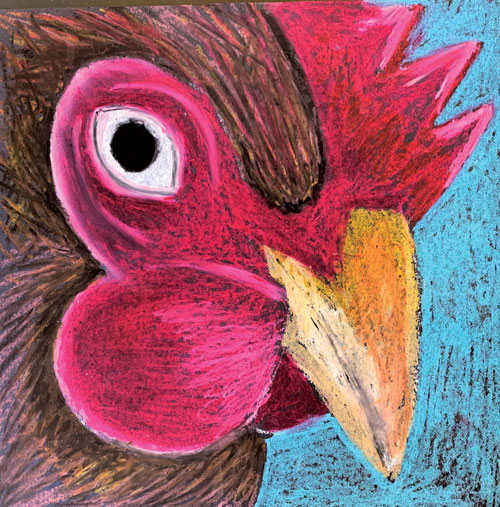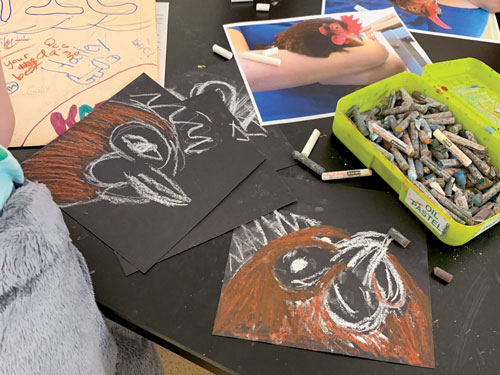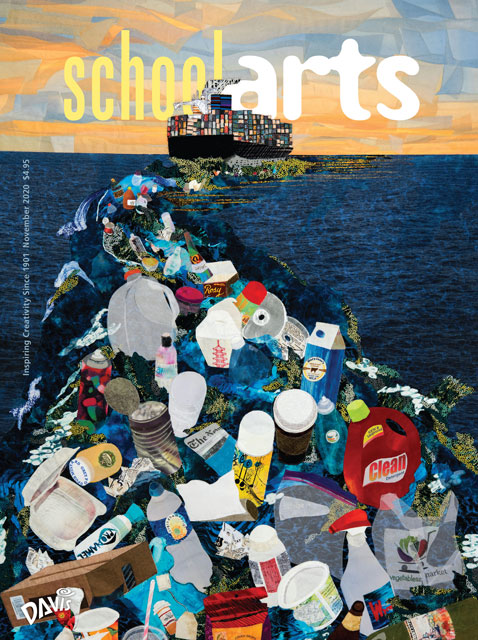 |
| A student’s oil pastel chicken. |
Meg is passionate about expanding the zoo’s outreach programs and interested in crafting interdisciplinary programs that impact learners in a meaningful way. Similarly, I’m always looking for opportunities to teach integrated lessons in my art room while finding new and exciting ways to engage my creative and energetic fourth-graders.
Working from my need to cover drawing concepts typically taught through still life, Meg explained the concept she conceived in February 2018, describing it as the “not-so-still still-life.” Meg worked with me to create an experience that integrated art, science, and live animals into a lesson that was actually doable in a public school setting.
Before the Visit
My fourth-grade students had an hour with Meg and the ambassador animals from the zoo. I knew Meg was going to bring three animals, which amounted to seventeen minutes with each animal. To prepare, I used the class time before the visit to talk about drawing from observation, scientific drawing, and note-taking. I then timed students drawing, taking notes, and photographing (using tablets) several wooden animal models I had in my supply closet. Students focused on capturing the most vital information, while also photographing details. These were the basics they would need to hit the ground running when Meg and the ambassador animals visited the following week.
 |
| Students work from their photos of the visiting animals. |
Ambassador Animals
On the day of the visit, the entire school was buzzing with the news of live animals. Meg brought with her a chicken named Lolita, a bearded dragon named Billy Dee, and a rainbow boa constrictor named Laurel (Hardy stayed home). Meg chose these animals for their beautiful colors, textures, and level of interaction. It’s not every day you get to have a chicken running around your art room! Students clung to every word and fact that Meg shared while staying focused on drawing and photographing. Meg was phenomenal at managing both the animals and students, focusing on the material needs of students as they worked.
After the Visit
After completing their sketches with the animals present, students drew from this experience as inspiration to create more complex works of art. During the visit, one thing that struck me was how each student had become fixated on one natural element or fact about one of the animals—something they connected with or thought was cool or interesting. Using this as inspiration, I challenged students to represent a single aspect or fact about one of the animals to create an oil pastel drawing on black paper. I asked them to use the sketches, notes, and photographs they took the previous week as resources to create the piece. The final artworks took two additional class periods and was a 9" (23 cm) square drawing that extended beyond the plane in least two places.
Great Results
This project was a great success thanks to the creativity and dedication of the education department at Roger Williams Park Zoo and the very open, trusting, and forward-thinking nature of my school administration. My students had the opportunity to study science, biology, and observational drawing while being the passionate, excited, and creative artists they are.
Jacob Ginga is an art teacher at Field School in Weston, Massachusetts. gingaj@weston.org
NATIONAL STANDARDS
Connecting: Synthesize and relate knowledge and personal experiences to make art.
RESOURCE
Roger Williams Park Zoo: rwpzoo.org/schools-educators
View this article in the digital edition.




